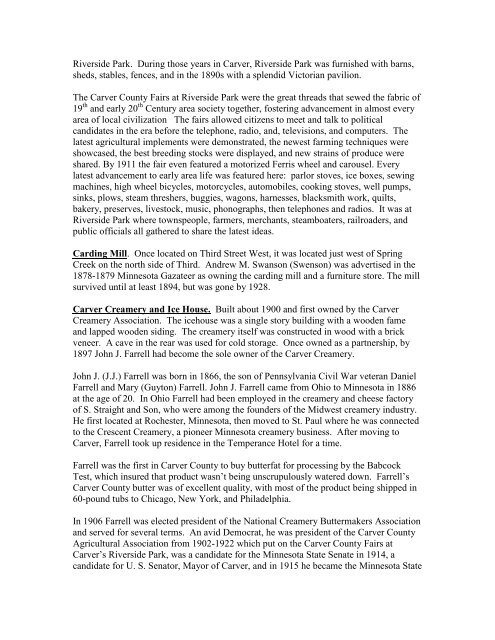Historic Homes and Businesses in Carver - Carver County Historical ...
Historic Homes and Businesses in Carver - Carver County Historical ...
Historic Homes and Businesses in Carver - Carver County Historical ...
Create successful ePaper yourself
Turn your PDF publications into a flip-book with our unique Google optimized e-Paper software.
Riverside Park. Dur<strong>in</strong>g those years <strong>in</strong> <strong>Carver</strong>, Riverside Park was furnished with barns,<br />
sheds, stables, fences, <strong>and</strong> <strong>in</strong> the 1890s with a splendid Victorian pavilion.<br />
The <strong>Carver</strong> <strong>County</strong> Fairs at Riverside Park were the great threads that sewed the fabric of<br />
19 th <strong>and</strong> early 20 th Century area society together, foster<strong>in</strong>g advancement <strong>in</strong> almost every<br />
area of local civilization The fairs allowed citizens to meet <strong>and</strong> talk to political<br />
c<strong>and</strong>idates <strong>in</strong> the era before the telephone, radio, <strong>and</strong>, televisions, <strong>and</strong> computers. The<br />
latest agricultural implements were demonstrated, the newest farm<strong>in</strong>g techniques were<br />
showcased, the best breed<strong>in</strong>g stocks were displayed, <strong>and</strong> new stra<strong>in</strong>s of produce were<br />
shared. By 1911 the fair even featured a motorized Ferris wheel <strong>and</strong> carousel. Every<br />
latest advancement to early area life was featured here: parlor stoves, ice boxes, sew<strong>in</strong>g<br />
mach<strong>in</strong>es, high wheel bicycles, motorcycles, automobiles, cook<strong>in</strong>g stoves, well pumps,<br />
s<strong>in</strong>ks, plows, steam threshers, buggies, wagons, harnesses, blacksmith work, quilts,<br />
bakery, preserves, livestock, music, phonographs, then telephones <strong>and</strong> radios. It was at<br />
Riverside Park where townspeople, farmers, merchants, steamboaters, railroaders, <strong>and</strong><br />
public officials all gathered to share the latest ideas.<br />
Card<strong>in</strong>g Mill. Once located on Third Street West, it was located just west of Spr<strong>in</strong>g<br />
Creek on the north side of Third. Andrew M. Swanson (Swenson) was advertised <strong>in</strong> the<br />
1878-1879 M<strong>in</strong>nesota Gazateer as own<strong>in</strong>g the card<strong>in</strong>g mill <strong>and</strong> a furniture store. The mill<br />
survived until at least 1894, but was gone by 1928.<br />
<strong>Carver</strong> Creamery <strong>and</strong> Ice House. Built about 1900 <strong>and</strong> first owned by the <strong>Carver</strong><br />
Creamery Association. The icehouse was a s<strong>in</strong>gle story build<strong>in</strong>g with a wooden fame<br />
<strong>and</strong> lapped wooden sid<strong>in</strong>g. The creamery itself was constructed <strong>in</strong> wood with a brick<br />
veneer. A cave <strong>in</strong> the rear was used for cold storage. Once owned as a partnership, by<br />
1897 John J. Farrell had become the sole owner of the <strong>Carver</strong> Creamery.<br />
John J. (J.J.) Farrell was born <strong>in</strong> 1866, the son of Pennsylvania Civil War veteran Daniel<br />
Farrell <strong>and</strong> Mary (Guyton) Farrell. John J. Farrell came from Ohio to M<strong>in</strong>nesota <strong>in</strong> 1886<br />
at the age of 20. In Ohio Farrell had been employed <strong>in</strong> the creamery <strong>and</strong> cheese factory<br />
of S. Straight <strong>and</strong> Son, who were among the founders of the Midwest creamery <strong>in</strong>dustry.<br />
He first located at Rochester, M<strong>in</strong>nesota, then moved to St. Paul where he was connected<br />
to the Crescent Creamery, a pioneer M<strong>in</strong>nesota creamery bus<strong>in</strong>ess. After mov<strong>in</strong>g to<br />
<strong>Carver</strong>, Farrell took up residence <strong>in</strong> the Temperance Hotel for a time.<br />
Farrell was the first <strong>in</strong> <strong>Carver</strong> <strong>County</strong> to buy butterfat for process<strong>in</strong>g by the Babcock<br />
Test, which <strong>in</strong>sured that product wasn‟t be<strong>in</strong>g unscrupulously watered down. Farrell‟s<br />
<strong>Carver</strong> <strong>County</strong> butter was of excellent quality, with most of the product be<strong>in</strong>g shipped <strong>in</strong><br />
60-pound tubs to Chicago, New York, <strong>and</strong> Philadelphia.<br />
In 1906 Farrell was elected president of the National Creamery Buttermakers Association<br />
<strong>and</strong> served for several terms. An avid Democrat, he was president of the <strong>Carver</strong> <strong>County</strong><br />
Agricultural Association from 1902-1922 which put on the <strong>Carver</strong> <strong>County</strong> Fairs at<br />
<strong>Carver</strong>‟s Riverside Park, was a c<strong>and</strong>idate for the M<strong>in</strong>nesota State Senate <strong>in</strong> 1914, a<br />
c<strong>and</strong>idate for U. S. Senator, Mayor of <strong>Carver</strong>, <strong>and</strong> <strong>in</strong> 1915 he became the M<strong>in</strong>nesota State


